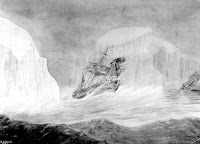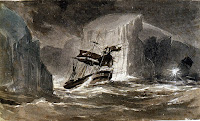Progress of the March 13, 1842 Erebus-Terror collision as
reported by witnesses (Campbell, Appendix 11), compiled and unified chronologically; with selected terminology
The two ships are retreating north towards the Falklands. The weather is poor, a strong gale blows with snow showers.
Aboard the Terror: Captain on deck. Early morning ice-blink sighted ahead and port bow [on the left], ship going
eight knots, topsails reefed. Captain orders to haul up to clear it [to avoid without turning round]. Erebus
signals to keep further off, Terror abandons manoeuvre, closing the blink
rapidly. About to attempt again at 12:50, assumes Erebus has finally
seen the ice ahead (but not the berg on the left). All hands on deck.
Aboard the Erebus: On Terror’s starboard beam [right side] under ¼ of a mile. Ship going seven
knots, topsails close-reefed [slowing down] – the watch on the fore yard taking in the last reef, ready to round to until daylight. Iceberg
sighted, all hands on deck, hauls to the wind on the port tack, observes
Terror running down on her.
Both
ships haul to the wind on opposite tacks – Terror is turning to the right, Erebus to the left [see diagram]; with Terror unable to clear
both Erebus and the bergs, the ships come in contact
- Erebus heaves all aback [takes the wind out of the sails to cut speed], impact still throws almost everyone off their feet; entangled, the ships drift towards the icebergs
- Terror
comes across Erebus’ bows [Terror's right side looking forward faces Erebus' front]; Erebus strikes Terror on starboard cat-head,
breaks anchor in two, takes both away, carries away flying jibboom,
jibboom, lower studding-sail boom; Erebus loses bowsprit close off at
the bows (the gammoning) [Terror loses secondary structures on and around her bowsprit, Erebus loses a mast]
- Erebus
hits Terror for the second time, on main beam [continuing to the left, hits Terror amidships], loses own fore-top-mast
close to the cap, cat-head and anchor; breaks
up Terror’s rubbing pieces [impact pieces], tears iron sheathing
- Terror breaks away Erebus’ bower anchor and embeds it in her starboard side [as shown in the paintings; dislodged in heavy seas a week later]
- Erebus hits Terror further aft [still continuing left], splinters Terror’s outside strengthening pieces; yard arms striking, Terror’s booms and boom irons come down [the ships are now side by side, heading in the opposite directions]
- Terror sets fore-sail and braces the head yards up to clear [her masts are intact]
Erebus strikes Terror at mizzen-mast [Terror's after part against Erebus' fore], smashes the quarter boat, breaks the ice-plank [ice observation station], shatters more strengthening pieces, tears off iron work, davits; Erebus’ gunwales forward cut down to the deck The Escape. Erebus and Terror (Davis)
The Escape. Erebus and Terror (Davis)- Ships separate, Erebus carries away Terror’s spanker boom, Terror smashes Erebus’ quarter boat [after part against after]
- Clearing,
Terror finds iceberg close under her lee; turning sharply, heads for the dark space sighted
earlier, helm put a-starboard; Captain manoeuvres Terror through the opening narrower than double breadth of the ship
“Hard-a-port”
was screamed out from forward (then indeed hope died within us);
“Hard-a-port; brace round the head-yards.” “Shiver the main-top-sail,”
cried the Captain, as if he was steering into any harbour. (Davis, p. 28)
- Erebus observes Terror escaping; cannot make sail due to wreckage – fore-sail split and unmanageable due to top-mast lying across it; no room to wear round; Captain orders a stern-board, takes ¾ of an hour to get ready; gig and quarter boats washed away going stern-way [reversing]
- Both iceberg walls avoided, Erebus follows Terror
- Relatively safe Terror burns blue light; Erebus answers immediately upon emergence half an hour later, signals "All is well, we can repair all our damages", Terror replies "Thank God, we are the same"; order to shelter; ships wait for daylight (04:00) to assess and clear up.
Terminology
• Nares, G.S., Seamanship, 3rd ed., source
• Steffy, J. Richard, The Oxford Handbook of Maritime Archaeology, source
Beams. – Horizontal timbers lying across the ship, to support the decks and connect the two sides.
Boom-irons. – On the jib-boom, and the lower and topsail yards, to support the flying jib-boom and the studding-sail booms.
 Bow. – The forward part of a hull, specifically, from the point where the sides curve inward to the stem.
Bow. – The forward part of a hull, specifically, from the point where the sides curve inward to the stem.Cat-head. – A piece of timber projecting from each bow of the ship to support a bower anchor.
Davits. – Wooden outriggers projecting from the ship's side to hoist the boats up to.
Masts
- The mainmast. – Is the middle and largest mast of the three.
- The foremast. – Is the furthest forward, and is the next in size to mainmast.
- The mizzenmast. – Is the aftermost and smallest mast of the three.
Each mast, taken as a whole, is composed of four pieces, each of which has its distinguishing name: The lower masts, the topmasts, the top-gallant masts, the royal masts. To distinguish any particular mast, one of the principal names, fore, main, or mizzen, is prefixed to its other name.
- The bowsprit. – Projects out from the bows.
- The jib-boom. – Is outside of, and supported by the bowsprit.
- The flying jib-boom. – Is outside of the jib-boom, and is supported by it and the bowsprit.
- Gammoning (bowsprit). – [Secures] the bowsprit down in its bed.
Sails
The sails are spread upon yards, one of which is crossed upon each mast; or upon half yards, called gaffs, on the after side of a mast; or upon stays [a rope supporting any mast from forward] or booms. Each sail derives its name from the mast, stay, or boom, upon which it is set. The yards, gaffs, and booms are named the same as the sails which they spread.
- The spanker. – [A sail] set upon a gaff, the mizzen trysail mast, and boom, abaft the mizzen mast.
- Studding sails are those set outside the square sails on each side of the ship, and are spread at the top upon yards, and at the bottom by booms.
- Yard-arm. – The ends of a yard where the rigging is placed.
Rule of the road
Ships on a wind passing close – The one on the starboard tack keeps the wind, port tack gives way.
Sea Terms
Hard-a-port – helm command, turning sharply to the left.
Hove to – keeping the ship stationary, by making one sail act against another.
Shiver the topsail – change the attitude of the yards so the sail goes slack.
Manoeuvring
- Tacking, going about, staying – going round from one tack to the other, passing head to the wind.
- Wearing – going round from one tack to the other, passing stern to the wind.
- To weather – to pass on the weather side of anything.
Weather side – the side against which the wind blows.
Lee side – the opposite to the weather side.



